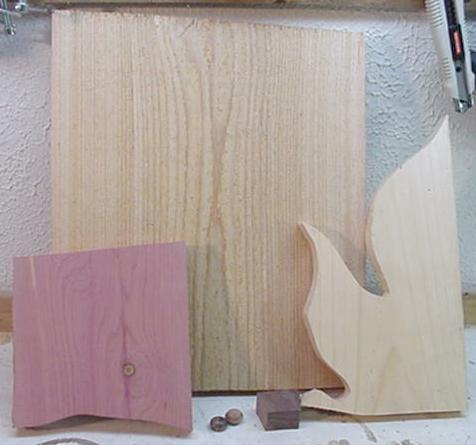Every intarsia project begins with a pattern.
Fortunately patterns are abundant. Suppliers listed in our Sources
Section offer them by the hundred. You can build eagles, lighthouses, praying hands,
sailing ships, old cars, grizzly bears, fluffy kittens, ... etc. The list of project
patterns is very long.
Beginners usually start with a commercial pattern. But many intarsians (intarsia
builders) soon begin creating their own patterns. These may be based on photos, clip art
and similar sources or you could use your own original drawings. To design and build a
project from scratch is a highly satisfying creative experience. Selling these projects
for good prices works wonders for one’s self esteem.
For the demonstrator project in this guide, we’re going to build a little bear
named Teddy. He is one foot tall and made up of approximately 20
separate pieces of wood. Teddy is a typical beginner-level project. He’s also a good
demonstrator, since we will be using the same building processes creating him that are
used to create a 300 piece motorcycle.
For easy transfer to wood, Teddy’s pattern needs to be
drawn on or transferred to translucent material such as tracing paper or drafting vellum.
The semi-transparency of the material allows you to look through the pattern at the wood.
Thus you can see what an intarsia part looks like before you cut it out. Some commercial
patterns are supplied on suitable material while others are on plain paper. Patterns on
plain paper should be transferred to tracing paper.
Although an intarsia project begins with a pattern, the subject soon switches to wood.
Wood looms large among intarsians – and well it should, for it is our painter’s
palette. We like wood. We like its endless variety of color, texture, grain
pattern, weight, feel and smell. Sometimes, we discuss wood as if it were fine wine.
What do you need to know about wood to start? Not a thing. Nor is there any need to
become an expert. Award-winning intarsian Judy Gayle Roberts has built hundreds of
magnificent projects from a single species, western red cedar.
Like a painter selecting paints, an intarsian selects woods. Small projects, such as
our Teddy, typically contain three or four species. However, larger projects may contain a
dozen or more. Over time, most of us develop favorite species that we stock in quantity
and use in one project after another. We are proud of our choices. If you see a piece on
display in our Gallery section and wonder what it’s made
of, e-mail and find out.
If you know very little about wood and care even less, you can still build a
respectable version of Teddy from a single pine board. The pattern is glued to the board
and sawed to pieces. The various parts are then shaped, sanded, stained and glued back
together. Easy as it is, this so-called "Segmented
Woodwork" sells very well in the craft market.
If you’d like to take a look at our painter’s palette of woods, a number of
websites have photos. Unhappily, even the best photos fall short. A
picture of an apple is one thing, a real apple quite another.
For a look at reality, visit hardwood lumber companies in your area. In a well-stocked
outlet you’ll find several dozen species of domestic hardwoods, no two of them alike.
There is variety within species, as well – poplar that is gray, poplar that is green,
white pine that is blue, and so on. Then there are the exotics – lacewood,
purpleheart, yellowheart, zebrawood, and bloodwood (to name only a few), all of which bear
striking resemblance to their namesakes. The intarsian’s palette is large indeed.
Some of these woods are expensive, so perhaps this is the time to discuss how much
Teddy will cost. The answer is that he costs as much, or as little, as you wish. Built
from stained pine, he’d run about $1.75. Built from exotics, that same little bear
could cost upwards of $100. As we are going to build him, using four popular intarsia
woods, he should cost $3-$4.
One trick to reducing costs is to use the pricey stuff sparingly. For example, I like
to use zebrawood for inlays on the wings of hummingbirds. Recently, I paid $24 for a
knee-high board. Whew! On the other hand, it ought to be good for 500 birds.
The fourth wood is aromatic cedar, which is soft, easy to work, inexpensive and smells
wonderful in the bargain. While colors vary, you can find aromatic that is intense red,
often with yellow blotches or streaks. Aromatic cedar makes terrific flowers. On Teddy,
we’ll use it for his scarf, just to add a splash of color.
Before we start building, here are a couple of tips on buying wood for intarsia.
First, buy the widest boards you can find – in softwoods, 1 X 12s. In the long
run, wider boards are more economical.
Second, try to obtain all lumber in ¾" thickness. Experienced intarsians work
with wood of many different thicknesses, but that’s a bit much for a first project.
If boards must be planed and you don’t have access to a planer, it pays to shop
around. Buy your boards where they will be planed free or at minimal cost.
Finally, avoid buying lumber from home improvement warehouses. Their pine (that
mysterious "white wood") is just plain awful. The few hardwoods they stock are
shamelessly over-priced. Buy softwoods from a lumberyard that serves builders. Buy
hardwoods from a hardwood lumber company.
